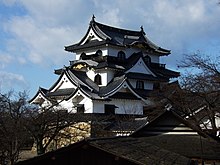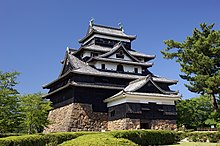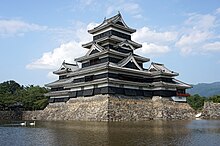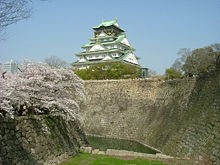Japanese castle
The traditional Japanese castle ( Japanese 城 , shiro ) was a large fortification built mainly of wood and stone .
It developed from wooden palisades from earlier centuries and received its most famous form in the 16th century. Like the European castles , the Japanese were built to protect strategically important places such as ports, river crossings or road crossings and almost always included the landscape in their defense.
Although they were built to last and used more stone than most other Japanese structures, most castles were mostly made of wood and many were destroyed over the years. This is particularly true of the later Sengoku period (" Warring States Period ") when many of the castles were rebuilt. However, many of the destroyed castles were rebuilt in the Sengoku and Edo periods , and others even later as national cultural heritage sites or museums. However, the latter are almost without exception built with modern building materials such as concrete and only have the appearance in common with their historical models.
The castle Matsue-jō in Matsue is perhaps the only castle in Japan, which has never attacked or damaged and is still preserved in their form of the 1611th
The other extreme is Hiroshima-jō Castle , which was destroyed when the atom bomb was dropped on Hiroshima and was only rebuilt as a museum in 1958.
The castle towns of the Edo period are called Jōkamachi .
etymology
From ancient times to the early Middle Ages, the Kanji 城 , originally meaning “city wall”, was used together with the Kanji 柵 , meaning “palisade”, for fortifications. Both were still read in Japanese ki at that time , such as Dewa no Ki ( 出 羽 柵 ) in today's Yamagata Prefecture and Ōno no Ki ( 大野 城 ) in Dazaifu in Fukuoka Prefecture . With ki something was referred to that separates between inside and outside, cf. kaki ( 垣 , German "fence") or seki ( 関 , German "barrier, obstacle; border station"). The Sino-Japanese readings were shiyau ( modern reading : jō ) for 城 or saku for 柵 .
Today's pure Japanese reading shiro can be traced back to the name of the province of Yamashiro . This was seen from the respective capitals of Japan in the province of Yamato behind the mountains and was therefore written 山 背 with the meaning "mountain back". The capital was moved in 794 via Nagaoka-kyō to Heian-kyō in this province, u. a. on the grounds that the mountains and rivers of this province form a natural fortress. The spelling of the province was therefore changed to 山城 with the meaning "mountain castle, mountain fortress", while maintaining the pronunciation. The name was then transferred to other mountains and castles on mountains used as fortresses. From the late Middle Ages onwards, shiro came up as the usual reading for 城 , e.g. B. in Bunmei-bon Setsuyōshū ( 文明 本 節 用 集 , dt. About: "Dictionary of the Bunmei time"), another name for the Zatsujiroisho ( 雑 字 類 書 ) published in 1474 .
In Okinawa , 城 is pronounced as suku , but often preceded by the honorary prefix gu .
history
Originally intended purely as a fortification, the main purpose of the Japanese castle was military defense. Soon, however, they became the residence of the daimyō (feudal lord) and a symbol of his power, and also served to impress and threaten rivals, not only with their defenses, but also with their size and elegant architecture, interior and decoration. In 1576, Oda Nobunaga was one of the first to build such a palatial castle, Azuchi-jō Castle . This is Japan's first castle, a tower-shaped keep ( 天守閣 , Tenshukaku had) and the later systems as Toyotomi Hideyoshi Osakajo or Tokugawa Ieyasu's Edo jō inspired.
Some particularly powerful families controlled not just one, but an entire chain of castles, which consisted of a main castle ( honjō ) and a number of secondary castles ( shijō ) distributed over their territory . Although the shijō were sometimes fully developed castles with stone bases, they often consisted only of wood and earthworks. A system of beacons, drums , or conch horns was often set up for communication over the great distance between the castles . Odawara-jō the later Hōjō and their network of satellite castles is considered to be one of the most important examples of this honjō-shijō system. The Hōnjō controlled so much land that a hierarchy of satellite castles had to be created.
Before the Sengoku period (around the 16th century), most of the castles were called yamajiro (mountain castle). Although most of the later castles were built on mountains or hills, these were built "out of the mountains". The trees were cleared away and the stone and bottom of the mountain were sculpted into rough fortifications. Trenches were dug as an obstacle for attackers and stones were laid out to roll them down onto them. Moats were created by diverting mountain rivers. The buildings consisted mainly of clay-covered wattle with thatched roofs or occasionally wooden shingles. Small openings in the walls allowed bows or firearms to be fired. The main weakness of this construction is its poor stability. Thatched roofs burn even more easily than wood, weather and earth erosion did not allow particularly large and heavy structures. Eventually the stone base for the castle came into use. Here, the top of the hill was enclosed in a layer of small pebbles, on which a layer of larger stones was placed without mortar. This support allowed larger, heavier and more permanent structures and led to the development of the "typically Japanese" castle construction, which this article focuses on.
A castle complex ( 城郭 / 城廓 , jōkaku ) after around 1570 usually consists of several rings, adapted to the terrain. The innermost ring is called the main ring ( 本 丸 , hon-maru ). It consists of defensive structures with the castle tower. Further areas around this are called 2nd ring ( 二 の 丸 , ni-no-maru ), 3rd ring ( 三 の 丸 , san-no-maru ) etc., although these need not always be complete rings. If the main ring is only extended in one direction, one also speaks z. B. from the Westring ( 西 の 丸 , nishi-no-maru ). The often sprawling residence ( 御 殿 , goten ) consisted of the prince's reception and living rooms ( 表 御 殿 , omote-goten ) and the household rooms ( 大 奥 , ō-oku ). Depending on the location of the main ring, a distinction is made between three types of castle complexes:
- The most common is the hill castle type ( 平 山城 , hirayamajiro ), in which the main ring is on a hill and the residence is often at the foot of the hill. Examples are Matsue-jō , Hikone-jō .
- There is also the Niederungsburg type ( 平城 , hirajiro ), in which all rings are on one level. Examples are Nagoya-jō , Matsumoto-jō .
- Finally, there is the rare mountain castle ( 山城 , yamajiro ) type, in which the main ring is located high in the mountains as an independent complex. The residence is located at the foot of the mountain. Examples are Bitchū Matsuyama-jō and Ishimura-jō , whose first system dates from the 13th century.
In contrast to Europe , where the advent of the cannon heralded the end of the age of castles, Japanese castle building was paradoxically driven by the introduction of firearms. The Japanese used cannons very rarely, as they could only be obtained from foreigners at high prices and were difficult to cast themselves. A few castles boasted of their “rampart guns”, but these seem to have been little more than arquebuses and did not have the firepower of real cannons. If siege weapons were used in Japan at that time, it was mostly trebuchets or catapults of the Chinese style and these were mainly used as anti-personnel weapons. Attempts were also made to set fire to the castle with incendiary arrows. There is no record that the goal of destroying the castle walls ever found its way into Japanese siege strategies. Against the arquebus that emerged in the 16th century, wooden palisades no longer offered adequate protection, so that castles with stone walls and bases emerged.
Of the castles, almost all of which survived the Edo period unmolested, only castle towers and ramparts with watchtowers are preserved today, while the actual residences have completely disappeared, with the exception of Nijō Castle in Kyoto, where at least part of the residence is original is. Of the (always uninhabitable) castle towers, only twelve (including the towers of Hikone, Himeji, Matsue and Matsumoto shown here) have survived from the Edo period, all the others are replicas - mostly made of concrete, but occasionally also of wood - from the 20th century ./21. Century. These include the castle towers of Kumamoto, Nagoya (destroyed in 1945), Okayama (destroyed in 1945) and Osaka (destroyed several times, rebuilt in 1931).
See also
swell
- Benesch, Oleg. "Castles and the Militarization of Urban Society in Imperial Japan," Transactions of the Royal Historical Society , Vol. 28 (Dec. 2018), pp. 107-134.
- Oscar Ratti, Adele Westbrook: Secrets of the Samurai. Castle Books, Edison, NJ, 1973
- Stephen Turnbull: Samurai Armies 1550-1615 . Osprey Publishing, Oxford 1979
- Stephen Turnbull: The Samurai Sourcebook . Cassell & Co., London 1998
- Stephen Turnbull: Was in Japan 1467-1615 . Osprey Publishing, Oxford 2002
Individual evidence
- ↑ http://www.gsi.go.jp/KIDS/map-sign/tizukigou/h08-01-01siroato.htm
- ↑ a b Kogo Daijiten ( 古語大 辞典 ). Kadokawa, 1987, quoted in: Kazuo Nishimura: し ・ ろ (城) の 語 源 . August 7, 2000, Retrieved December 6, 2008 (Japanese).
- ↑ 展示 No.27 〔雑 字 類 書〕 . National Parliamentary Library , accessed March 27, 2009 (Japanese).
Web links
- Japanese Castle Explorer : Interactive Map (English)
- Japanese Castles - The ultimate guide to additional information on Japanese castles








